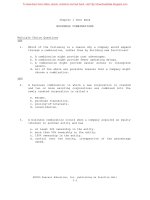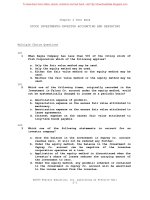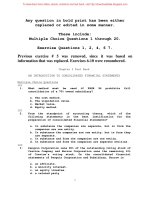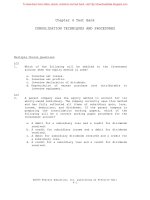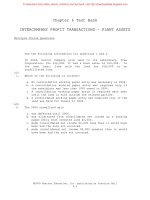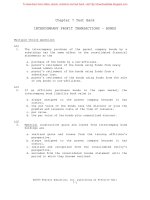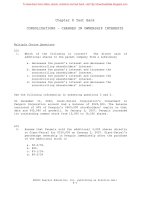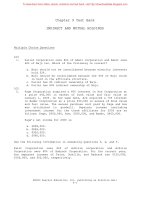Test bank advanced accounting 10e by beams chapter 03
Bạn đang xem bản rút gọn của tài liệu. Xem và tải ngay bản đầy đủ của tài liệu tại đây (116.58 KB, 32 trang )
To download more slides, ebook, solutions and test bank, visit
Any question in bold print has been either
replaced or edited in some manner.
These include:
Multiple Choice Questions 1 through 20.
Exercise Questions 1, 2, 4, 6 7.
Previous exercise # 5 was removed, since it was based on
information that was replaced. Exercises 6-10 were renumbered.
Chapter 3 Test Bank
AN INTRODUCTION TO CONSOLIDATED FINANCIAL STATEMENTS
Multiple Choice Questions
LO1
1.
What method must be used if FASB
consolidation of a 70% owned subsidiary?
a.
b.
c.
d.
LO1
2.
94
prohibits
full
The cost method.
The Liquidation value.
Market value.
Equity method.
From the standpoint of accounting theory, which of
following statements is the best justification for
preparation of consolidated financial statements?
the
the
a. In substance the companies are separate, but in form the
companies are one entity.
b. In substance the companies are one entity, but in form they
are separate.
c. In substance and form the companies are one entity.
d. In substance and form the companies are separate entities.
LO2
3.
Penguin Corporation owns 90% of the outstanding voting stock of
Crevice Company and Burrow Corporation owns the remaining 10%
of Crevice’s voting stock. On the consolidated financial
statements of Penguin Corporation and Subsidiary, Burrow is
a.
b.
c.
d.
an affiliate.
a minority interest.
an equity investee.
a related party
1
To download more slides, ebook, solutions and test bank, visit
LO2
4.
A major motivation for FASB’s creation of Statement No. 94 was
a. temporary control was not being disclosed properly.
b. the elimination off-balance sheet financing
c. situations occurred where subsidiary control did not lie
with the parent company.
d. the risk of subsidiary legal reorganization or bankruptcy
was not disclosed.
LO2
5.
Muttonbird Inc. has 90% ownership of Beach Company, but should
exclude Beach under FASB 94 if
a.
b.
c.
d.
LO2
6.
Subsequent
to
an
acquisition,
the
parent
company
and
consolidated financial statement amounts would not be the same
for
a.
b.
c.
d.
LO3
7.
Beach is in a regulated industry.
Muttonbird uses the equity method for Beach.
Muttonbird expects to sell Beach within a year.
Beach is in a foreign country and records its books in a
foreign currency.
investments in unconsolidated subsidiaries.
investments in consolidated subsidiaries.
capital stock.
ending retained earnings.
On June 1, 2005, Gull Company acquired 100% of the stock of
Scrap Inc. On this date, Gull had Retained Earnings of $200,000
and Scrap had Retained Earnings of $100,000. On December 31,
2005, Gull had Retained Earnings of $240,000 and Scrap had
Retained Earnings of $120,000. The amount of Retained Earnings
that appeared in the December 31, 2005 consolidated balance
sheet was:
a.
b.
c.
d.
$240,000.
$260,000.
$300,000.
$360,000.
2
To download more slides, ebook, solutions and test bank, visit
LO3
8.
Scrubwren Corporation acquired a 100% interest in Heath Company
for $1,780,000 when Heath had no liabilities. The book values and
fair values of Heath's assets were
Book Value
$ 400,000
200,000
600,000
$1,200,000
Current assets
Equipment
Land & buildings
Total assets
Fair Value
$ 700,000
400,000
800,000
$1,900,000
Immediately following the acquisition, equipment will be
included on the consolidated balance sheet at
a.
b.
c.
d.
LO4
9.
$300,000.
$340,000.
$360,000.
$400,000.
A newly acquired subsidiary had pre-existing goodwill on its
books. The parent company's consolidated balance sheet will
a. not show any value for the subsidiary's pre-existing
goodwill.
b. treat the goodwill similarly to other intangible assets of
the acquired company.
c. not show any value for the pre-existing goodwill unless all
other assets of the subsidiary are stated at their full
fair value.
d. always show the pre-existing goodwill of the subsidiary at
its book value.
LO4
10.
The unamortized excess account is
a. a contra-equity account.
b. used in allocating the amounts paid for recorded balance
sheet accounts that are above or below their fair values.
c. used in allocating the amounts paid for each asset and
liability that are above or below their book values,
especially
when
numerous
assets
or
liabilities
are
involved.
d. the excess purchase cost that is attributable to goodwill.
3
To download more slides, ebook, solutions and test bank, visit
LO5
11.
On January 1, 2005, Tern purchased 90% of Costal Corporation’s
outstanding shares for $1,400,000 when the fair value of
Costal’s assets were equal to the book values.
The balance
sheets of Tern and Costal Corporations at year-end 2004 are
summarized as follows:
Assets
$
Liabilities
Capital stock
Retained earnings
$
Tern
5,900,000 $
Costal
1,450,000
700,000 $
3,600,000
1,600,000
250,000
1,000,000
200,000
If a consolidated balance sheet was prepared immediately after
the business combination, the minority interest, would be
a.
b.
c.
d.
LO5
12.
On July 1, 2005, when Worm Company’s total stockholders’ equity
was $180,000, Bird Corporation purchased 7,000 shares of Worm’s
common stock at $30 per share. Worm Company had 10,000 shares
of common stock outstanding both before and after the purchase
by Bird, and the book value of Worm’s net assets on July 1,
2005 was equal to the fair value. On a consolidated balance
sheet prepared at July 1, 2005, goodwill would be
a.
b.
c.
d.
LO5
13.
$100,000.
$155,556.
$140,000.
$520,000.
$30,000.
$40,000.
$50,000.
$120,000.
Bowerbird Inc acquired 60% of the outstanding stock of Mimicry
Company in a business combination. The book values of Mimicry’s
net assets are equal to the fair values except for the
building, whose net book value and fair value are $400,000 and
600,000, respectively. At what amount is the building reported
on the consolidated balance sheet?
a.
b.
c.
d.
$360,000.
$400,000.
$520,000.
$600,000.
4
To download more slides, ebook, solutions and test bank, visit
LO5
14.
In the preparation of consolidated financial statements, which
of the following intercompany transactions must be eliminated
as part of the preparation of the consolidation working papers?
a. All revenues, expenses, gains, deductions, receivables, and
payables.
b. All revenues, expenses, gains, and deductions but not
receivables and payables.
c. Receivables and payables but not revenues, expenses, gains,
and deductions.
d. only sales revenue and cost of goods sold.
LO6
15.
Pardolate Corporation paid $200,000 for a 60% interest in
Arthropod Inc on January 1, 2005, when Arthropod had Capital
Stock of $200,000 and Retained Earnings of $100,000. Fair
values of identifiable net assets were the same as recorded
book values. During 2005, Arthropod had income of $30,000,
declared dividends of $10,000, and paid $5,000 of dividends.
On December 31, 2005, Pardolate will have
a.
b.
c.
d.
LO6
16.
Spinebill Corporation bought 80% of Nectar Company’s common
stock at its book value of $500,000 on January 1, 2005. During
2005, Nectar reported net income of $150,000 and paid dividends
of $45,000. At what amount should Spinebill’s Investment in
Nectar account be reported on December 31, 2005?
a.
b.
c.
d.
LO6
``
investment in Salem account of $240,000.
investment in Salem account of $218,000.
goodwill of $33,333.
dividends receivable of $3,000.
$500,000
$548,000
$584,000
$605,000
Weebill Corporation bought 80% of Tree Company’s common stock
at its book value of $800,000 on January 2, 2005 for $700,000.
The law firm of Dewey, Cheatam and Howe did $25,000 to
facilitate the purchase.
At what amount should Weebill’s
Investment in Tree account be reported on January 2, 2005?
a.
b.
c.
d.
$640,000.
$665,000.
$700,000.
$725,000.
LO7
5
To download more slides, ebook, solutions and test bank, visit
18.
Bellbird Corporation acquired an 80% interest in Honey Inc for
$130,000 on January 1, 2005, when Honey had Capital Stock of
$125,000 and Retained Earnings of $25,000. Bellbird’s separate
income statement and a consolidated income statement for
Bellbird Corporation and Subsidiary as of December 31, 2005,
are shown below.
Sales revenue
Income from Corporal
Cost of sales
Other expenses
Noncontrolling
interest income
Net income
Bellbird
150,000
11,600
(
60,000 )
(
20,000 )
$
$
81,600
Consolidated
234,750
$
$
(
(
100,000 )
50,000 )
(
3,150 )
81,600
Honey’s separate income statement must have reported net
income of:
a.
b.
c.
d.
LO7
19.
In the consolidated income statement of Wattlebird Corporation
and its 85% owned Forest subsidiary, the noncontrolling
interest income was reported at $45,000. What amount of net
income did the Forest have for the year?
a.
b.
c.
d.
LO8
20.
$13,750.
$14,750.
$15,750.
$15,250.
$52,941
$38,250
$235,000
$300,000.
Push-down accounting
a. requires a subsidiary to use the same accounting principles
as its parent company.
b. is required by the SEC if a subsidiary is wholly owned.
c. is required when the parent company uses the cost method to
account for its investment in the subsidiary.
d. results in a push-up residual account on the subsidiaries
books.
6
To download more slides, ebook, solutions and test bank, visit
Exercises
LO4
Exercise 1
Alarm Bird Inc. acquired an 85% interest in Clock Corporation on
January 2, 2005 for $38,000 cash when Clock had Capital Stock of
$15,000 and Retained Earnings of $25,000. Clock’s assets and
liabilities had book values equal to their fair values except for
inventory that was undervalued by $2,000. Balance sheets for Alarm
Bird and Clock on January 2, 2005, immediately after the business
combination, are presented in the first two columns of the
consolidated balance sheet working papers.
Alarm Bird Corporation and Subsidiary
Consolidated Balance Sheet Working Papers
at January 2, 2005
Eliminations
Alarm
Bird
ASSETS
Cash
Accounts
Receivable-net
$
Inventories
Plant assets-net
Investment in
Clock
Clock
Debit
68,000
$ 4,000
75,000
9,000
39,000
10,000
170,000
35,000
38,000
Total Assets
$
390,000
$58,000
EQUITIES
Payables
$
120,000
$18,000
100,000
15,000
170,000
25,000
390,000
$58,000
Capital stock
Retained
Earnings
Minority
Interest
TOTAL EQUITIES
$
7
Credit
Balance
Sheet
To download more slides, ebook, solutions and test bank, visit
Required:
Complete the consolidation balance sheet working papers for Alarm Bird
and subsidiary at January 1, 2005.
LO4
Exercise 2
On January 1, 2005, Myna Corporation issued 10,000 shares of its own
$10 par value common stock for 9,000 shares of the outstanding stock
of Berry Corporation in an acquisition. Myna common stock at January
1, 2005 was selling at $70 per share. Just before the business
combination, balance sheet information of the two corporations was as
follows:
Cash
Inventories
Other current assets
Land
Plant and equipment-net
$
$
Liabilities
Capital stock, $10 par value
Additional paid-in capital
Retained earnings
$
$
Myna
Book
Value
25,000 $
55,000
110,000
100,000
660,000
950,000 $
Berry
Book
Value
12,000 $
32,000
90,000
30,000
250,000
414,000 $
Berry
Fair
Value
12,000
36,000
110,000
90,000
375,000
623,000
220,000 $
500,000
170,000
60,000
950,000 $
50,000 $
100,000
40,000
224,000
414,000
50,000
Required:
1. Prepare the journal entry on Myna Corporation’s books to account
for the business combination.
2. Prepare a consolidated balance sheet for Myna Corporation and
Subsidiary immediately after the business combination.
8
To download more slides, ebook, solutions and test bank, visit
LO5
Exercise 3
The consolidated balance sheet of Treecreeper Corporation and Ants
Farm, its 90% owned subsidiary, as of December 31, 2005, contains the
following accounts and balances:
Treecreeper Corporation and Subsidiary
Consolidated Balance Sheet
at December 31, 2005
Cash
Accounts receivable-net
Inventories
Other current assets
Plant assets-net
Goodwill from consolidation
$
$
Accounts payable
Other liabilities
Capital stock
Retained earnings
Minority interest
Balances
19,000
70,000
110,000
85,000
290,000
39,000
613,000
$
73,000
70,000
350,000
80,000
40,000
613,000
$
Treecreeper Corporation acquired its 90% interest in Ants Farm on
January 1, 2005, when Ants Farm had $150,000 of Capital Stock and
$70,000 of Retained Earnings. Ants Farm’s net assets had fair values
equal to their book values when Treecreeper acquired its interest. No
changes have occurred in the amount of outstanding stock since the
date of the business combination. Treecreeper uses the equity method
of accounting for its investment.
Required: Determine the following amounts:
1. The balance of Treecreeper's Capital Stock and Retained Earnings
accounts at December 31, 2005.
2. Cost of Treecreeper's purchase of Ants Farm on January 1, 2005.
3. Ants Farms’s stockholders' equity on December 31, 2005.
4. Treecreeper’s Investment
December 31, 2005.
in
Ants
9
Farm
account
balance
at
To download more slides, ebook, solutions and test bank, visit
LO5
Exercise 4
Monarch Corporation paid $180,000 for a 75% interest in Stem Co.’s
outstanding
Capital
Stock
on
January
1,
2005,
when
Stem’s
stockholders’ equity consisted of $150,000 of Capital Stock and
$50,000 of Retained Earnings. Book values of Stem’s net assets were
equal to their fair values on this date. The adjusted trial balances
of Monarch and Stem on December 31, 2005 were as follows:
Cash
Dividends receivable
Other current assets
Land
Plant assets-net
Investment in Stem
Cost of sales
Other expenses
Dividends
Accounts payable
Dividends payable
Capital stock
Retained earnings
Sales revenue
Income from Stem
$
Packer
8,250
7,500
40,000
50,000
100,000
195,000
225,000
45,000
25,000
695,750
$
40,750
$
$
150,000
75,000
400,000
30,000
695,750
35,000
10,000
150,000
50,000
190,000
$
435,000
$
$
Stem
35,000
50,000
30,000
150,000
$
125,000
25,000
20,000
435,000
Required: Complete the partially prepared consolidated balance sheet
working papers that appear below.
10
To download more slides, ebook, solutions and test bank, visit
Monarch Corporation and Subsidiary
Consolidated balance Sheet Working Papers
at December 31, 2005
Eliminations
Monarch
ASSETS
Cash
Dividends
Receivable
Other current
Assets
$
Stem
Debit
8,250 $ 35,000
7,500
40,000
50,000
50,000
30,000
Plant assets
100,000
150,000
Investment in
Stem
195,000
Land
Total Assets
$
EQUITIES
Accounts payable $
Dividends
Payable
Capital stock
Retained
Earnings
TOTAL EQUITIES
$
400,750 $285,000
40,750 $ 35,000
10,000
150,000
150,000
210,000
70,000
400,750 $285,000
11
Credit
Balance
Sheet
To download more slides, ebook, solutions and test bank, visit
LO5
Exercise 5
Zoo Inc paid $268,000 to purchase 80% of the outstanding stock of
Bird Corporation, on December 31, 2005. The following year-end
information was available just before the purchase:
Cash
Accounts Receivable
Inventory
Land
Plant and equipment-net
$
$
Accounts Payable
Bonds Payable
Capital stock, $10 par value
Capital stock, $15 par value
Additional paid-in capital
Retained earnings
Zoo
Book
Value
378,000 $
130,000
240,000
220,000
660,000
1,628,000 $
Bird
Book
Value
40,000 $
76,000
50,000
80,000
200,000
446,000 $
Bird
Fair
Value
40,000
76,000
55,000
55,000
215,000
440,000 $
468,000
200,000
11,000 $
100,000
11,000
95,000
$
$
200,000
320,000
1,628,000 $
225,000
80,000
30,000
446,000
Required:
1. Prepare Zoo’s consolidated balance sheet on December 31, 2005.
12
To download more slides, ebook, solutions and test bank, visit
LO5
Exercise 6
On July 1, 2005, Magpie Corporation issued 23,000 shares of its own
$2 par value common stock for 35,000 shares of the outstanding stock
of Insect Inc. in an acquisition. Magpie common stock at July 1, 2005
was selling at $14 per share. Just before the business combination,
balance sheet information of the two corporations was as follows:
Cash
Inventories
Other current assets
Land
Plant and equipment-net
$
$
Liabilities
Capital stock, $2 par value
Additional paid-in capital
Retained earnings
Magpie
Book
Value
25,000 $
55,000
110,000
100,000
660,000
950,000 $
Insect
Book
Value
17,000 $
42,000
40,000
45,000
220,000
364,000 $
Insect
Fair
Value
17,000
47,000
30,000
35,000
280,000
409,000
220,000 $
500,000
170,000
60,000
950,000 $
70,000 $
100,000
90,000
104,000
364,000
75,000
$
$
Required:
1. Prepare the journal entry on Magpie
account for the business combination.
Corporation’s
books
to
2. Prepare a consolidated balance sheet for Magpie Corporation and
Subsidiary immediately after the business combination.
13
To download more slides, ebook, solutions and test bank, visit
LO5
Exercise 7
Manucode Corporation paid $279,000 for 70% of Trumpet Corporation’s
$10 par common stock on December 31, 2005, when Trumpet Corporation’s
stockholders’ equity was made up of $200,000 of Common Stock, $60,000
Additional Paid-in Capital and $40,000 of Retained Earnings.
Trumpet’s identifiable assets and liabilities reflected their fair
values on December 31, 2005, except for Trumpet’s inventory which was
undervalued by $50,000 and their land which was undervalued by
$20,000. Balance sheets for Manucode and Trumpet immediately after
the business combination are presented in the partially completed
working papers.
14
To download more slides, ebook, solutions and test bank, visit
Manucode Corporation and Subsidiary
Consolidated Balance Sheet Working Papers
at December 31, 2005
Eliminations
Manucode Trumpet
ASSETS
Cash
Accounts
receivable-net
$
Inventories
20,000
30,000
125,000
110,000
30,000
80,000
320,000
160,000
Investment in
Trumpet
279,000
Total Assets
$
800,000 $400,000
EQUITIES
Current
liabilities
$
110,000 $100,000
TOTAL EQUITIES
$
Credit
Balance
Sheet
26,000 $ 20,000
Land
Plant assets –
net
Capital stock
Additional paidin capital
Retained
earnings
Debit
400,000
200,000
100,000
60,000
190,000
40,000
800,000 $400,000
Required:
Complete the consolidated balance sheet working papers for Manucode
Corporation and Subsidiary.
15
To download more slides, ebook, solutions and test bank, visit
LO6
Exercise 8
Bower Corporation paid $5,000 for a 60% interest in Fig Inc. on
January 1, 2005 when Fig’s stockholders’ equity consisted of $5,000
Capital Stock and $2,500 Retained Earnings. Fig’s assets and
liabilities were fairly valued on this date. Two years later, on
December 31, 2006, the balance sheets of Bower and Fig are summarized
as follows:
Bower Corporation and Subsidiary
Consolidated balance Sheet Working Papers
at December 31, 2006
Eliminations
Bower
ASSETS
Current assets
$
Fixed assets
Investment in
Fig
Fig
Debit
12,550
$ 4,000
21,550
6,500
5,900
Total Assets
$
40,000
$10,500
EQUITIES
Liabilities
$
10,000
$ 1,500
20,000
5,000
10,000
4,000
40,000
$10,500
Capital stock
Retained
Earnings
TOTAL EQUITIES
Credit
Balance
Sheet
$
Required:
Complete the consolidated balance sheet working
Corporation and Subsidiary at December 31, 2006.
16
papers
for
Bower
To download more slides, ebook, solutions and test bank, visit
LO7&8
Exercise 9
Currawong Corporation paid $500,000 for 80% of the outstanding voting
common stock of Lizard Corporation on January 2, 2005 when the book
value of Lizard’s net assets was $460,000. The fair values of
Lizard’s identifiable net assets were equal to their book values
except as indicated below.
Lizard reported net income of $75,000 during
$35,000 were declared and paid during the year.
Inventories
Buildings-net
Note Payable
(sold in 2005)
(15-year life)
(paid in 2005)
$
Book
Value
80,000 $
200,000
20,000
2005;
dividends
of
Fair
Value
112,000
170,000
21,250
Required:
1. Prepare a schedule to allocate the cost/book differential to the
specific identifiable assets and liabilities.
2. Determine Currawong’s income from Lizard for 2005.
3. Determine the correct balance
account as of December 31, 2005.
17
in
the
Investment
in
Lizard
To download more slides, ebook, solutions and test bank, visit
SOLUTIONS
Multiple Choice Questions
1
d
2
b
3
b
4
b
5
c
6
b
7
a
8
c
The parent’s retained earnings
Purchase cost
Current asset fair value
Excess to non-current assets
Fair value of non-current assets
Allocation shortfall
Equipment share of shortfall:
$400,000/$1,200,000 X $120,000 =
Allocation to equipment:
$400,000 - $40,000 =
9
c
10
c
11
b
$1,400,000 / 90% =
$1,555,556. 10% of
$1,555,556 = $155,556
12
d
Bird’s cost
= 7,000 x $30
Implied fair value of Worm
($210,000 / 70%)
Less: Book value
Goodwill acquired
13
$
$
$
$
1,780,000
700,000
1,080,000
1,200,000
120,000
40,000
360,000
$
(
$
210,000
300,000
180,000 )
120,000
d
14
a
15
c
Pardolate’s cost
18
$
600,000
$
200,000
To download more slides, ebook, solutions and test bank, visit
Implied fair value of Arthropod
($200,000 / 60%)
Less: Book value
Goodwill acquired
16
c
333,333
(
$
584,000
Investment cost + 80% (subsidiary
income) – (80%)(subsidiary
dividends = $500,000 + $120,000
- $36,000 =
$
17
d
18
c
$3,150/0.20 = $15,750
19
d
$45,000/15% = $300,000
20
d
19
300,000 )
33,333
To download more slides, ebook, solutions and test bank, visit
Exercise 1
Preliminary computations
Fair value (purchase price) of 90% interest acquired $
January 2, 2005
Implied fair value of Clock ($38,000 / 90%
Book value of Clock’s net assets
(
Excess cost over book value acquired =
$
Allocation of excess of cost over book value:
Inventory
Remainder to goodwill
Excess of fair value over book value
$38,000
$44,706
40,000)
4,706
$
2,000
2,706
4,706
$
Alarm Bird Corporation and Subsidiary
Consolidated Balance Sheet Working Papers
at January 1, 2005
Eliminations
Clock
Alarm
Debit
Credit
Bird
ASSETS
Cash
Accounts
Receivable-net
$
Inventories
Plant assetsNet
Investment in
Charlie
Balance
Sheet
68,000
$ 4,000
$72,000
75,000
9,000
84,000
39,000
170,000
10,000 a
$2,000
51,000
35,000
205,000
38,000
a
Goodwill
a
$38,000
2,706
2,706
Total
Assets
$
390,000
$58,000
$414,706
EQUITIES
Payables
$
120,000
$18,000
$138,000
Capital stock
Retained
Earnings
Minority
Interest
Total equities
100,000
15,000 a
$15,000
100,000
170,000
25,000 a
25,000
170,000
a
$
390,000
6,706
$58,000
$414,706
44,706
20
6,706
44,706
To download more slides, ebook, solutions and test bank, visit
Exercise 2
Requirement 1:
Investment in Berry Co.
Common stock
Paid-in capital
700,000
100,000
600,000
Requirement 2:
Preliminary computations
Fair value (purchase price) of 90% interest acquired January $
2, 2005
Implied fair value of Berry ($700,000 / 90%
Book value of Clock’s net assets
(
Excess fair value over book value acquired =
$
Allocation of excess of cost over book value:
Inventory
Other current assets
Land
Plant assets
Remainder to goodwill
Excess of fair value over book value
21
$700,000
$777,778
364,000)
413,778
$
4,000
20,000
60,000
125,000
204,778
$
413,778
To download more slides, ebook, solutions and test bank, visit
Myna Corporation and Subsidiary
Consolidated Balance Sheet Working Papers
at January 1, 2005
Myna
ASSETS
Cash
$
25,000
Berry
Eliminations
Debit
Credit
$ 12,000
Balance
Sheet
$
37,000
Inventories
Other current
Assets
55,000
32,000 b
$ 4,000
91,000
110,000
90,000 b
20,000
220,000
Land
100,000
30,000 b
60,000
190,000
Plant assets
Goodwill
Investment in
Berry
Total
Assets
660,000
250,000 b
b
125,000
204,778
1,035,000
204,778
$ 1,650,000
$414,000
$1,777,778
EQUITIES
Liabilities
$
$ 50,000
270,000
Capital stock
Additional paidin capital
Retained
earnings
Minority
Interest
Total equities
b
a
700,000
220,000
$413,778
286,222
600,000
100,000 a
100,000
600,000
770,000
40,000 a
40,000
770,000
60,000
224,000 a
224,000
60,000
a 77,778
$ 1,650,000
$414,000
22
77,778
$1,777,778
To download more slides, ebook, solutions and test bank, visit
Exercise 3
Preliminary computations
Requirement 1:
On the consolidated balance sheet, the balance in the Capital Stock
and Retained Earnings accounts will be those of the parent, so the
Capital Stock balance is $350,000, and the Retained Earnings
balance is $80,000.
Requirement 2
(Ant Farm’s equity on January 1, 2005)x(90%) =
($220,000)x(90%)
Original goodwill =
Original acquisition cost =
$
$
198,000
39,000
237,000
Ant
Farm’s
stockholders’
equity
=
(minority
interest) divided by (minority interest percentage)
$
=($40,000/10%)
400,000
Requirement 4
Treecreeper’s book value in 90% of Ants Farm at
December 31, 2005 = ($400,000 (from above)) x 90%
$
Plus: goodwill (from balance sheet)
Balance in Investment account at December 31, 2005
$
360,000
39,000
399,000
Requirement 3
23
To download more slides, ebook, solutions and test bank, visit
Exercise 4
Preliminary computations
Fair value (purchase price) of 75% interest acquired $
on January 1, 2005
Implied fair value of Stem (($180,000 / 75%)
$
Book value of Stem’s net assets
$
Excess cost over book value acquired
$
240,000
200,000
40,000
Initial investment cost
Income from Stem: (75%)($40,000)=
Dividends ($20,000)(75%) =
$
180,000
30,000
-15,000
Balance in Investment in Stem at December 31,2005
$
195,000
180,000
Monarch Corporation and Subsidiary
Consolidated Balance Sheet Working Papers
at December 31, 2005
Monarch
ASSETS
Cash
Dividends
Receivable
Other current
Assets
$
8,250
$ 35,000
Plant assets
Investment in
Stem
b
$ 7,500
40,000
50,000
90,000
50,000
30,000
80,000
100,000
150,000
250,000
195,000
a
Goodwill
a
$
Balance
Sheet
$ 43,250
7,500
Land
Total
Assets
Eliminations
Debit
Credit
Stem
400,750
$265,000
24
$ 40,000
195,000
40,000
$503,250
To download more slides, ebook, solutions and test bank, visit
EQUITIES
Accounts payable $
Dividends
Payable
Capital stock
Retained
Earnings
Minority
Interest
Total equities
40,750
$ 35,000
$75,750
10,000 b
7,500
2,500
150,000
150,000 a
150,000
150,000
210,000
70,000 a
70,000
210,000
a
$
400,750
65,000
65,000
$265,000
$503,250
267,500
267,500
Exercise 5
Requirement 1:
Preliminary computations
Fair value (purchase price) of 80% interest acquired $
on December 31, 2005
Implied fair value of Bird (($268,000 / 80%)
$
Book value of Bird’s net assets
$
Excess cost over book value acquired
$
25
268,000
335,000
335,000
0

